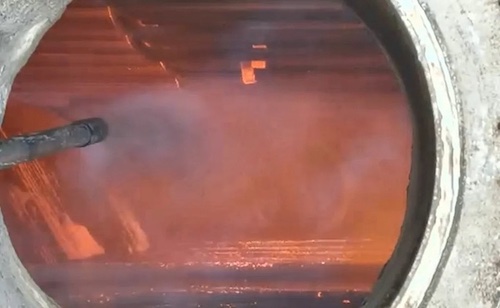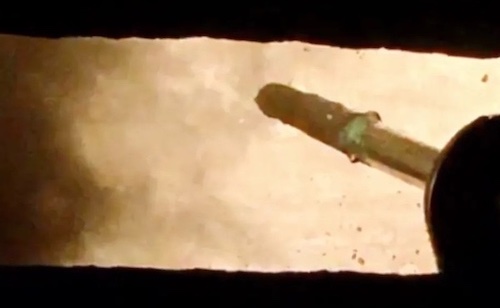
media coverage
After nearly 30 years in the boiler business, and I’ve witnessed too many plants suffer from endless clinker problems. In the early days, I followed my mentor into the furnace, hammer in hand, breaking off those stubborn chunks. Later, I devoted myself to studying every de-slagging technique I could find. And after all these years, I can tell you this with confidence: brute force is never the answer. The real solution lies in the right ‘maintenance recipe’ - a smarter way to keep your boiler running clean and efficient.”
01. Crack the Clinker Code - Effortless Solutions!
Case 01 - A 300MW Coal-Fired Boiler
Just a few years ago, a 300MW coal-fired plant was burning extra coal worth a new car every month because of stubborn clinker buildup.Manual cleaning by four workers couldn’t keep up - until they switched to a daily dose of our anti-clinker solution. The result? Almost a year of trouble-free operation, with zero clinker shutdowns.
Case 02 - A Waste-to-Energy Plant
At a waste-to-energy facility, hard, corrosive clinkers once caused a two-week outage that cost millions. But with liquid chemical treatment, deposits loosened in just two days, and the boiler was back online in a week. Now, regular use means fewer shutdowns - and workers say they’ve finally stopped “fighting clinkers every day.”
Why Chemicals Beat Manual Cleaning Every Time?
Attack Clinker at Its Root - whether it’s fly ash deposits in coal boilers or molten slag in metallurgical furnaces - is essentially a hard shell formed by high-temperature chemical reactions of minerals. The active ingredients in our chemical anti-clinker solution work like “dissolving enzymes,” breaking down the crystal structure of the deposits. The hard chunks soften and fall off on their own. Simply put, it’s like soaking limescale in vinegar - no scraping required, the scale just melts away.

Surface Cleaning Isn’t Enough!
Some operators still believe “if you can see it being cleaned, it must be effective.” That’s a trap. Manual cleaning often removes only the surface clinker, while hidden deposits in tube gaps - the “dead corners” - remain and quickly reconnect. Chemical treatment follows the flue gas to every heated surface, even in hard-to-reach bends and joints, ensuring thorough protection.
Invest a Little, Save a Lot!
Over the years, I’ve seen plants take the wrong path: either skimping on anti-clinker treatment and facing costly tube bursts, or trusting unproven tricks that make things worse. A boiler is like a trusted partner - treat it right, and it delivers. Using chemical treatment may seem like an added cost, but the savings are huge: less fuel consumption, lower maintenance costs, and fewer downtime losses - often worth ten times the cost of the product.
02. 3 Easy Steps to a Clinker - Free Boiler
Step 1: Clinker Severity Diagnosis and Treatment Guidelines
- Mild Clinker (<5mm layer): Apply anti-clinker agent directly during routine operation for preventive maintenance.
- Moderate Clinker (5~20mm layer): Increase the concentration of the anti-clinker agent and combine with soot blowing for effective removal.
- Severe Clinker (>20mm layer): Manually remove large clinker chunks first, then treat the remaining deposits with chemical agent.
Step 2: Choosing the Right Anti-Clinker Agent
With a wide variety of anti-clinker agents available on the market, it is recommended to first analyze the clinker composition and select the product based on your specific needs:
- High-Temperature Type: Resistant to temperatures above 1000°C, ideal for coal-fired boilers.
- Chemical Reaction Type: Raises ash melting point, induces localized micro-explosions, and alters the crystal structure of the clinker layer. Available in liquid or powder formulations for flexible dosing under different operating conditions.
Step 3: Targeted Furnace Anti-Clinker Application
- Coal-Fired Boilers: Blend the agent with the fuel to act throughout the combustion process.
- Oil/Gas-Fired Boilers: Inject the agent directly into the furnace using a spray nozzle.
- Biomass Boilers: Use formulations specifically designed to resist tar-related clinker formation.

03. The Trusted Solution for Lasting Boiler Performance
Say Goodbye to Stubborn Clinker - For Real!
Still battling boiler clinker? Stop wasting time and money on guesswork! Most anti-clinker agents on the market are hit-or-miss, and every boiler is different. Here’s what works: POLYTE® 30XX Series - UK-imported, top-quality chemical formula, plus clinker analysis and custom treatment plans tailored to your boiler: No more blind dosing. No more recurring clinkers. Just reliable, long-lasting results.
Pro tip: Let the experts analyze your clinker first, then apply the right solution - it’s the difference between constant headaches and smooth, efficient boiler operation!
POLYTE®30A
Appearance: Blue-violet liquid
Density (20°C): 1.12 ± 0.05 g/cm³
pH (1.0% solution): 4.0~7.0
Properties: Non-corrosive to equipment, non-flammable
Packaging: 25 kg/drum
POLYTE®30C
Form: Powdered solid
Particle Size: ≤ 5~6 mm
Chemical Properties: Stable
Operating Temperature: 700~1200°C
Packaging: 25 kg /bag
A boiler is like an old companion - care for it properly, and it will serve you reliably for years. Rather than scrambling when clinkers become a serious problem, it’s far wiser to establish a scientific, proactive anti-clinker system now.
Real technology isn’t about complexity - it’s about making the complex effortlessly simple.